
As the two youngest electric vehicles to join Tesla’s fleet, the Model 3 and Model Y have quickly helped propel the automaker to a market cap over $600 billion. While both EVs share several of the same parts, they do remain unique from one another in many ways. While not exhaustive, this side by side comparison of Tesla’s Model 3 and its Model Y should help you get a basic idea for how these cars differ…
What is Tesla Model 3?
From the early years after Tesla’s inception, CEO Elon Musk was candid about the automaker’s goal of someday providing quality EVs all consumers who could afford to drive. With 2016’s announcement of its Model 3 sedan, Tesla came one step closer toward its goal of an EV at $35,000.
After an encouraging number of early reservations were made for Tesla’s most affordable model to date, the Model 3 debuted in 2017. Since then, it has cruised comfortably in the fast lane of sales. The EV currently sits as the world’s best selling all-electric vehicle and has accounted for a majority of the total Teslas sold in recent years.
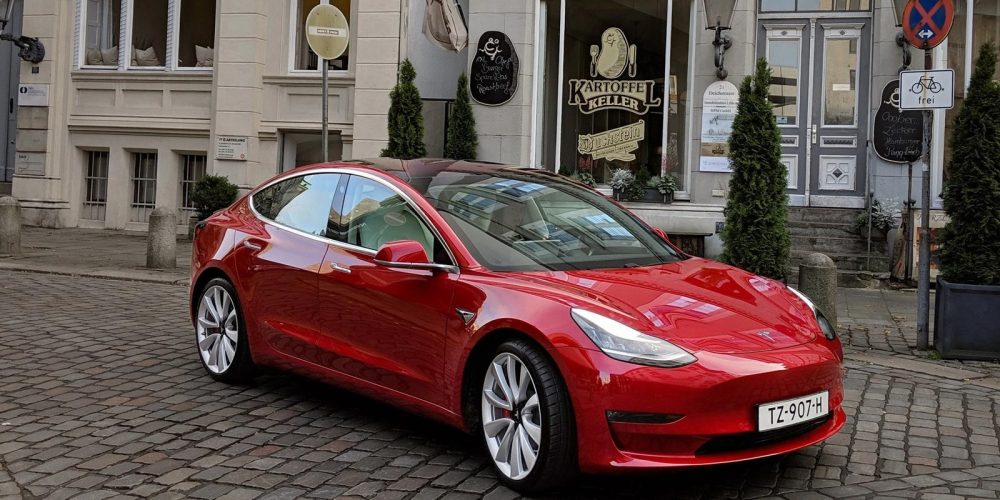
Tesla (briefly) sold a $35,000 version of the Model 3 to hit a price point originally promised by Elon Musk in years leading up to the first delivery. Back in November however, Tesla quietly removed this option during a refresh for its 2021 Model 3. The latest version sits at a purchase price of $39,490 for the Standard Range Plus trim with zero added features. More on pricing later, but first let’s get up to speed on the Model 3’s younger sibling, the Model Y.
What is Tesla Model Y?
Tesla unveiled its Model Y in 2019 as a smaller, crossover version of its larger and more established Model X mid-sized SUV. After beginning deliveries to customers in March of 2020, the Model Y remains the newborn in the Tesla family, but has still managed to make a significant splash in sales during its short tenure on the EV market.
According to the company’s Q3 2020 results, the Model Y along with the Model 3 combined for 89% of the total Tesla vehicles sold in the third quarter of 2020, which showcases how evident Tesla’s sales looking forward will rely on these two newer models. In fact, Electrek recently reported on Teslas push to deliver a record number of Model 3s and Model Ys to close out the fourth quarter of 2020.
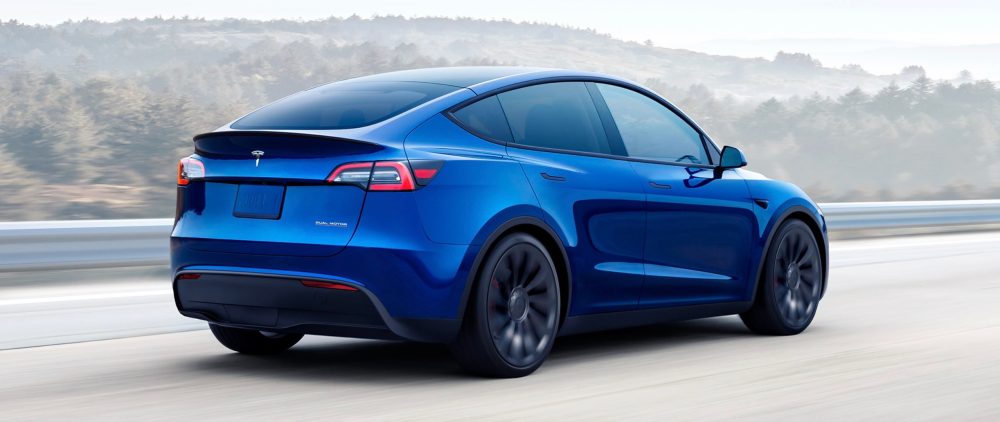
In joining the same assembly platform and its Model 3, Tesla’s Model Y shares many of the same parts. For example, with the 2021 Model 3 refresh, Tesla adopted the “chrome delete” of its exterior trims to match the design of the original Model Y. Furthermore, the Model Y was Tesla’s first EV to include its own designed heat pump, increasing both efficiency and range.
Electrek’s own Fred Lambert revealed in December 2020 that the Model 3’s refresh will include the same heat pump introduced on the Model Y. Most recently, both Tesla models will be receiving an updated headlight design across all global markets by early 2021. While both of these share much of the same mechanical DNA, they deviate from one another in terms of their exterior look and their performance options.
Last fall, Tesla CEO Elon Musk nixed a Standard Range Model Y option but still promised a rear wheel drive (RWD) Long Range Model Y to follow. It now appears that Tesla has gone back to Standard Range RWD Model Y, as it recently made this option available on its website. Almost as quickly as it was implemented, the Standard Range Model Y suddenly disappeared from Tesla’s website configurator. Electrek later reported that the RWD Model Y will instead remain available as an “off menu” item, because Elon Musk was not satisfied with its 244 mile range.
Here’s a breakdown of how the Model 3 and Model Y stack up side by side.
Performance
Generally speaking, each of these two Tesla models appear quite different as price friendly sedan versus a roomy crossover EV, but both options offer plenty in terms of range, top speed, and acceleration. The Model 3 wins for variety, offering three separate drivetrains compared to the two previously offered for the Model Y. Last fall, Elon Musk nixed the Standard Range Model Y option but still promised a rear wheel drive (RWD) Long Range Model Y to follow. It now appears that Tesla has gone back to Standard Range RWD Model Y, as it recently made this option available on its website.
Model Y
Speaking of the Model Y, let’s start there: Tesla’s newest EV now comes in three different trims. Tesla recently debuted its Standard Range RWD option. This was a recent addition to addition to the Model Y’s two dual-motor, AWD, Long Range and Performance options. According to Tesla’s website, the Standard Range RWD Model Y can travel 244 miles on a single charge, hit a top speed of 135 mph, and travel 0-60 mph in 5.3 seconds. The SR Model Y currently sits as an “off menu” item whose future remains uncertain. That being said, it did just receive its official EPA rating as one of the most efficient EVs in the world.
The current Long Range Model Y boasts an EPA estimated range of 326 miles, can reach a top speed of 135 mph and can accelerate from 0-60 mph in 4.8 seconds. Its Performance trim can travel 303 miles on a single charge, tops out at 155 mph and can do 0-60 in 3.5 seconds. Not bad in any category considering the EV also houses 68 cubic feet of cargo space compared to the 15 cubic feet of cargo space on the Model 3.
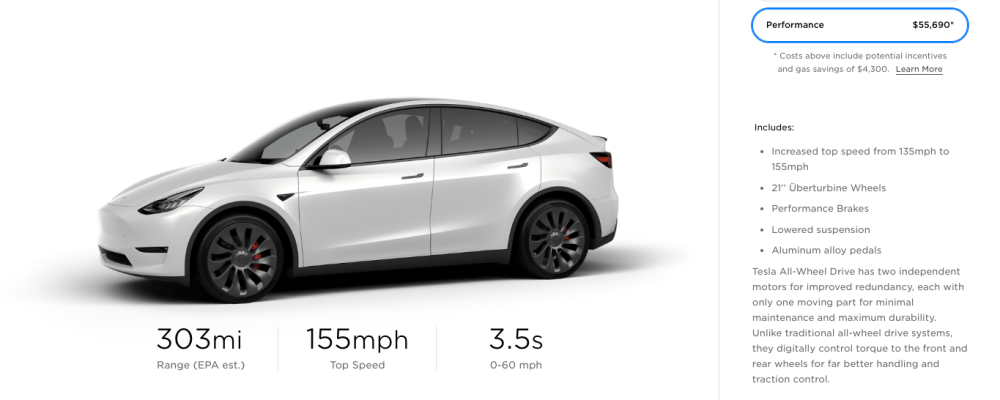
Model 3
The Model 3 also offers three drivetrains to choose from, highlighting various ranges and speeds based off a customer’s preferences. Its most affordable Standard Range Plus travels an EPA estimated 263 miles, has a top speed of 140 mph, and can hit 0-60 mph in 5.3 seconds. Moving to the Long Range trim, this Model 3 bests the Model Y Long Range by 27 miles at 353 miles per charge. It also tops its Model Y counterpart in top speed and acceleration, offering 145 mph and 0-60 in 4.2 seconds respectively. The Performance Model 3 is the same story, offering 315 miles of range, and a top speed of 162 mph while zooming 0-60 mph in 3.1 seconds.
If we consider the Standard RWD Model 3 as a standalone, cost-friendly option, the Model 3 Long Range and Performance trims best the Model Y all three categories above. With that said, the Model Y stats Model Y remain more than adequate given its increased weight (nearly 350 lbs more for Long Range and Performance trims). Additionally, either option offers much more overall space compared to the more compact Model 3.
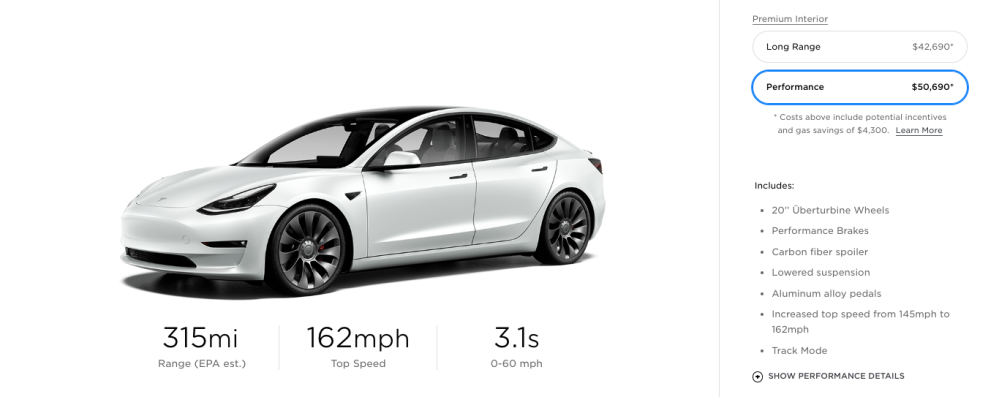
Interior
When the Model Y debuted this past spring, Electrek’s Fred Lambert got his hands on one and did a full review. As a Model 3 owner Fred was able to offer proper insight in comparing the two Tesla vehicles:
Looking out from the driver’s seat, you’d think you are inside of a Model 3. But once you got over how similar the experience is to Model 3, you start noticing some subtle differences that can make a big difference for some people.
First off, the slightly higher ground clearance makes it a little easier to get in and out of the car.
The interior is also a bit roomier and while the difference is not that big compared to Model 3, it feels a lot more spacious thanks to the lack of a beam separating the glass roof.
Electrek got its hands on a new Model Y earlier this year and compiled details of a full teardown inside and out. This is a great place to learn all the meticulous differences between the Model Y and the Model 3.
Exterior
As previously mentioned, these two Tesla vehicles share a large majority of the same parts (almost 70%). From the first reveal of the Model Y, many Tesla fans quickly pegged it as simply a taller Model 3. Electrek’s first spin with the Model Y when it came out certainly showed evidence to that assumption. However, there are subtle and effective changes present on the Model Y than help the electric SUV stand on its own.
For example, the front end of the Model Y resembles its assembly line counterpart at first glance, but the tweaks to its design on a taller and larger exterior help it step out of the Model 3’s shadow. Furthermore, the Model Y comes complete with a power liftgate full hatch trunk, a big wish for Model 3 owners. The Model 3 offers more than adequate cargo space for a sedan at 15 cubic feet total, but it pales in comparison to the 68 cubic feet of cargo capacity in the Model Y.
Drive
When it comes to driving, sedans tend to be more speedy and fun, but SUVs offer a better line of sight and a feeling of more safety sitting higher off the ground. The Model Y does offer more of a feeling of sitting higher up, although it realistically only sits one inch higher off the road than the Model 3. Having such a low center of gravity enabled by the battery pack works to the Model Y’s advantage as well. This helps Tesla’s youngest EV feel noticeably stable and connected to the road.
Additional features
Both Tesla options will get you where you need to go quickly and efficiently (albeit one option will give you more room for cargo). That being said, it may be the additional features that help steer you behind the wheel of one Tesla over the other. Both options offer a 15″ center touchscreen, 4 USB-C charging ports, wireless charging for two smartphones and tinted glass roofs with infrared protection.
As a larger EV, the Model Y comes with a tow hitch add-on capable of towing up to 3,500 lbs. for an additional $1,000. As for wheels, the Long Range Model Y cones with 19″ Induction Wheels or 20″ Gemini Wheels, while the Performance Trim automatically rolls out on 21’’ Überturbine Wheels. To compare, the Standard and Long Range Model 3s come with either 18″ Aero Wheels or 19″ Sport Wheels. The Performance trim also has Überturbine Wheels, although they’re only 20″ round.
Again, since the Model Y is a significantly larger EV compared to the Model 3, its second row seats independently fold down to store larger cargo. The Model Y is currently available in both a five seat and seven seat interior. Previously, Elon Musk stated that the seven seat Model Ys would begin deliveries in December. Most recently, the option is selectable on Tesla’s Model Y purchase page for an additional $3,000.
Regardless, it could be argued the Model Y has the upper hand in this category based on cargo space and towing capacity alone. As a result, it could be a viable option for anyone with a lot of people or large items to transport.
Prices
Performance, customizable options, and available features are of course important in any EV purchase. With that said, for many people the final deciding factor in a Tesla is price. As Tesla’s most affordable option, the Model 3 is less expensive than the Model Y when comparing any trim options. However, the Model Y offers more room with comparable performance at a price point that still ranks as Tesla’s second most affordable option in the fleet. Here’s how it breaks down.
Note that these prices are accurate as of the publish date, and we’ll keep them updated for you moving forward. Furthermore, these prices do not include the additional $1,200 for destination and documentation fees.
Model 3
As they say, “age before towing capacity,” so let’s start with the Model 3. Its Standard Range Plus trim begins at a starting purchase price of $39,490. It’s important to note that these base prices are with zero upgrades, and come with the standard white exterior paint. The Standard Range Plus can go as high as $53,990 if you were to add every top feature available. This includes red exterior paint, 19″ sport wheels, black and white interior, and full-self driving capabilities (which Fred still calls a Kickstarter campaign).
The Long Range Model 3 starts at $48,490 and can reach a top end price of $62,990 fully loaded. Last but certainly not least, the Performance version of the Model 3 starts at $56,990 and can go even higher to $69,990 with all available add-ons. Overall, your least costly option for a new Model 3 is about $39,000 while the most expensive version comes in just under $70,000. It’s worth noting these are the purchase prices on Tesla’s website and do not include gas savings or tax incentives.
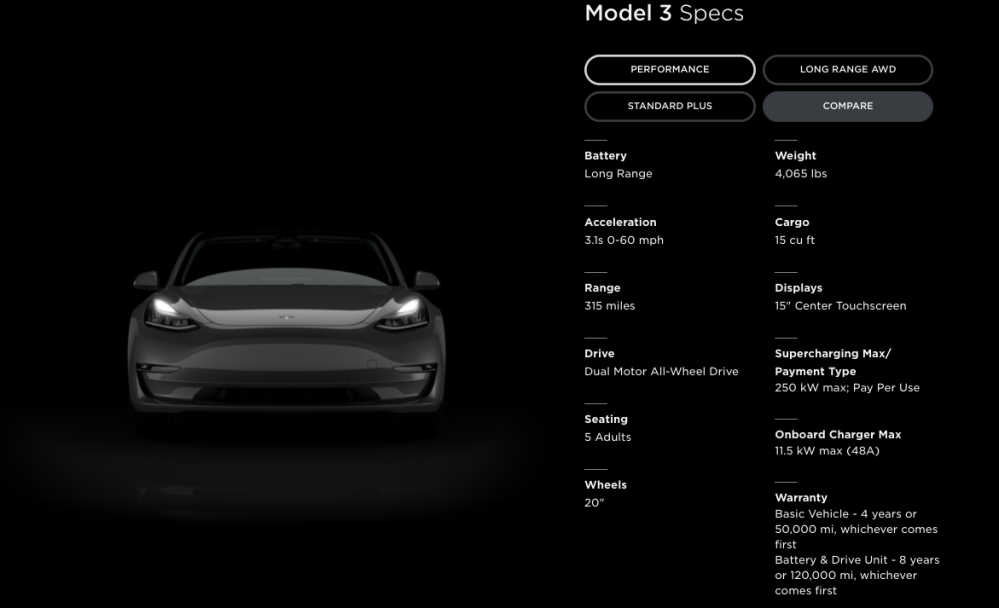
Model Y
As previously mentioned, Tesla (sort of) offers the “off menu” Standard Range RWD Model Y trim. It begins at a purchase price of $39,990 before any incentives or rebates, but can still go as high as $58,990 all-in. This includes all added features such as an extra $1,000 for a tow hitch, 20″ induction wheels, red paint, custom interior and full self driving (FSD) capabilities. This higher end price also includes the newly available seven-seat interior for an additional $3,000.
The two dual-motor options for the Model Y start relatively higher than the Model 3 prices and rise from there. The Long Range trim starts at a base price of $51,490 and rises to $70,490 with every available upgrade. This includes an extra $1,000 for the aforementioned tow hitch and $2,000 for 20″ Induction Wheels.
The Performance Model Y on the other hand, starts at $60,990 and expands upwards to $74,990 when fully loaded. All in all, a new Model Y will cost you about $40,000 minimum and can reach nearly $75,000 decked out before gas savings or state tax incentives.
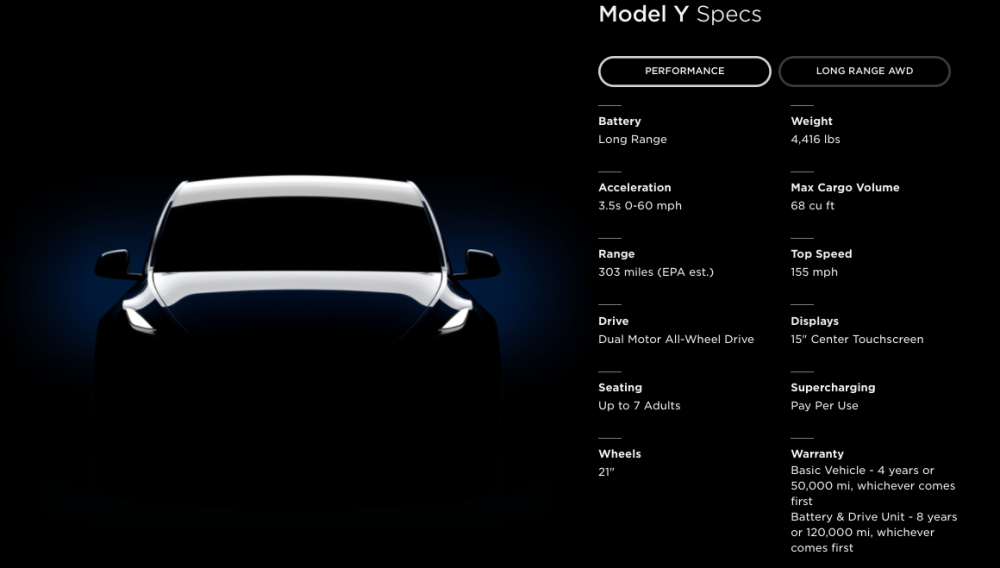
Which to choose: Tesla Model 3 or the Model Y?
In conclusion, there’s plenty of evidence as to why these two Teslas have made up a huge majority of the American automaker’s total sales in recent quarters. Both offer performance, intuitive design, and value no matter your budget. Similar yet different in their own unique way, either Tesla has the available options to give you plenty to enjoy in an electric vehicle.
Subscribe to Electrek on YouTube for exclusive videos and subscribe to the podcast.
Author: Scooter Doll
Source: Electrek



